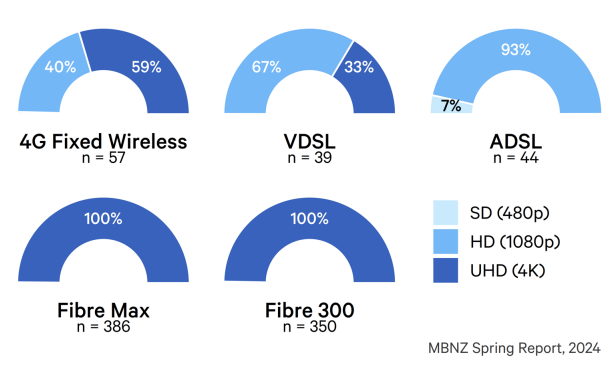Fibre vs Wireless Broadband - which is better in NZ?
Fibre is the clear winner when it comes to dependability of connection, lower ping times, lower jitter, and speed of internet connectivity available.
Got The Best Broadband Around?
Check Your Address Now!
Check
While both technologies include the term broadband, by their very design the quality of service is extremely different. Let’s take a look at the main areas of difference – speed, latency, and ease of installation.
Fibre vs Wireless broadband Speed comparison
Firstly let’s take a look at real-world download speed data as gathered over recent months across most major internet providers and connection types by Sam Knows and Commerce Commission. This fascinating New Zealand broadband data was released in their January 2024 broadband monitoring report. [source]
I think it’s worth noting that while running a speedtest on your connection is a useful metric, this data that they’ve gathered shows what real-world connectivity behaviour is like throughout New Zealand over recent times.

As we can see here Fibre 300 (which consumers would often compare with Fixed Wireless broadband) is 532% faster at downloading.
Beyond this, when compared with the very popular Fibre Max service we see that it is 1702% faster at downloading on average than Fixed Wireless broadband.
Woah.
And this continues to play out when you look at real-world YouTube streaming performance.
Here we see a chart of the highest YouTube video quality that was able to be streamed on each type of broadband connection.
It is clear to see that both Fibre 300 and Fibre Max dominate, with 4K/UHD video content able to be reliably streamed approximately 100% of the time, while fixed wireless broadband significantly worse at only 59%.
In fact, Fixed wireless beats only the very outdated DSL technology type in it’s streaming capability.

Fibre vs Wireless broadband Latency comparison
The next major area when it comes to the quality and usability of a broadband connection is latency, which impacts many areas of connectivity – but is especially evident in online gaming.
As you can see from the monitoring of connection quality in New Zealand, Fibre connections consistently achieve latency 7 times lower than fixed wireless (lower is better) for these popular game servers.

Ease of getting connected
Over the last several years as the fibre broadband (UFB) network has been rolled out across the country this has meant there has been a variety of wait times to get connected.
Obviously as connecting fibre does involve physically running a fibre optic cable from the street to the inside of your property, this is also a more involved process than plonking down a fixed wireless router on a shelf and plugging it in.
However, as the fibre rollout has progressed, a much greater percentage of homes and businesses now have a Fibre ONT already installed.
This dramatically speeds up the process of getting connected on Fibre, and simplifies it down to a very quick remote activation of the service once you’ve placed your fibre broadband order with your chosen provider.
Usually this can be activated within a day or two – and in fact I’ve seen plenty of cases where it has actually been activated on the same day the order was placed!
For those homes which don’t yet have a Fibre ONT installed, the vast majority of the population across New Zealand now have fibre at their property boundary, and for most people it will be a simple single day install process.
Interested in upgrading to Fibre broadband?
It’s super easy to see if you can get fibre at your place - just pop your address into the address checker, and you can see what your options are right away.
If you’d like to go ahead from there, you’re just a few clicks away - and our fantastic support and provisioning teams are here to help you get connected as quickly and easily as possible.
